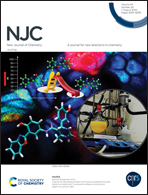A novel amperometric determination of flufenamic acid using CuMOF ribbons incorporated with activated carbon†
Abstract
Flufenamic acid (FFA) has anti-inflammatory, analgesic and antipyretic properties. We describe herein the preparation of a nanoribbon-like copper metal–organic framework (CuMOF) with an average length of 10 ± 5 μm and a width of 100 ± 50 nm via a simple hydrothermal approach. An amperometric sensor based on the activated carbon (AC)-supported ribbon-like CuMOF-modified electrode has been constructed for the detection of FFA. The AC–CuMOF nanostructure was characterized using scanning electron microscopy (SEM), electron diffraction X-ray spectroscopy (EDX) and X-ray diffraction (XRD) spectroscopy techniques. The peak current confirmed the excellent electrooxidation of FFA at the AC–CuMOF-modified glassy carbon electrode (GCE) and peak potential values resulting from cyclic voltammetry (CV) and amperometric (i–t) studies. The estimated values of the linear range (0.01 μM to 2210 μM), limits of detection (1.09 nM) and quantification revealed the enhanced electrocatalytic activity of the AC–CuMOF-modified GCE as compared to only CuMOF and AC. AC–CuMOF/GCE also possesses better repeatability and reproducibility along with good sensitivity (13.75 μA μM−1 cm−2). Even in the presence of other common potential interferents, our fabricated electrode displayed high selectivity towards FFA. The practicability demonstration of our sensor has been done in urine samples. Thus, AC–CuMOF/GCE can be a crucial platform in the determination of FFA.



 Please wait while we load your content...
Please wait while we load your content...